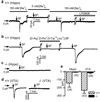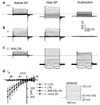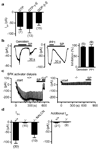Peptide neurotransmitters activate a cation channel complex of NALCN and UNC-80
- PMID: 19092807
- PMCID: PMC2810458
- DOI: 10.1038/nature07579
Peptide neurotransmitters activate a cation channel complex of NALCN and UNC-80
Abstract
Several neurotransmitters act through G-protein-coupled receptors to evoke a 'slow' excitation of neurons. These include peptides, such as substance P and neurotensin, as well as acetylcholine and noradrenaline. Unlike the fast (approximately millisecond) ionotropic actions of small-molecule neurotransmitters, the slow excitation is not well understood at the molecular level, but can be mainly attributed to suppressing K(+) currents and/or activating a non-selective cation channel. The molecular identity of this cation channel has yet to be determined; similarly, how the channel is activated and its relative contribution to neuronal excitability induced by the neuropeptides are unknown. Here we show that, in the mouse hippocampal and ventral tegmental area neurons, substance P and neurotensin activate a channel complex containing NALCN and a large previously unknown protein UNC-80. The activation by substance P through TACR1 (a G-protein-coupled receptor for substance P) occurs by means of a unique mechanism: it does not require G-protein activation but is dependent on Src family kinases. These findings identify NALCN as the cation channel activated by substance P receptor, and suggest that UNC-80 and Src family kinases, rather than a G protein, are involved in the coupling from receptor to channel.
Figures




Similar articles
-
UNC80 functions as a scaffold for Src kinases in NALCN channel function.Channels (Austin). 2009 May-Jun;3(3):161-3. doi: 10.4161/chan.3.3.8853. Epub 2009 May 27. Channels (Austin). 2009. PMID: 19535918 Free PMC article.
-
Extracellular calcium controls background current and neuronal excitability via an UNC79-UNC80-NALCN cation channel complex.Neuron. 2010 Nov 4;68(3):488-99. doi: 10.1016/j.neuron.2010.09.014. Neuron. 2010. PMID: 21040849 Free PMC article.
-
Properties of a slow nonselective cation conductance modulated by neurotensin and other neurotransmitters in midbrain dopaminergic neurons.J Neurophysiol. 1996 Sep;76(3):1968-81. doi: 10.1152/jn.1996.76.3.1968. J Neurophysiol. 1996. PMID: 8890307
-
The NALCN ion channel is a new actor in pancreatic β-cell physiology.Islets. 2010 Jan-Feb;2(1):54-6. doi: 10.4161/isl.2.1.10522. Islets. 2010. PMID: 21099296 Review.
-
New insights into the physiology and pathophysiology of the atypical sodium leak channel NALCN.Physiol Rev. 2024 Jan 1;104(1):399-472. doi: 10.1152/physrev.00014.2022. Epub 2023 Aug 24. Physiol Rev. 2024. PMID: 37615954 Review.
Cited by
-
Ion Channels Involved in Substance P-Mediated Nociception and Antinociception.Int J Mol Sci. 2019 Mar 30;20(7):1596. doi: 10.3390/ijms20071596. Int J Mol Sci. 2019. PMID: 30935032 Free PMC article. Review.
-
Breathing matters.Nat Rev Neurosci. 2018 Jun;19(6):351-367. doi: 10.1038/s41583-018-0003-6. Nat Rev Neurosci. 2018. PMID: 29740175 Free PMC article. Review.
-
The NALCN ion channel is activated by M3 muscarinic receptors in a pancreatic beta-cell line.EMBO Rep. 2009 Aug;10(8):873-80. doi: 10.1038/embor.2009.125. Epub 2009 Jul 3. EMBO Rep. 2009. PMID: 19575010 Free PMC article.
-
N-benzhydryl quinuclidine compounds are a potent and Src kinase-independent inhibitor of NALCN channels.Br J Pharmacol. 2020 Aug;177(16):3795-3810. doi: 10.1111/bph.15104. Epub 2020 Jun 17. Br J Pharmacol. 2020. PMID: 32436268 Free PMC article.
-
Elevated Expression and Activity of Sodium Leak Channel Contributes to Neuronal Sensitization of Inflammatory Pain in Rats.Front Mol Neurosci. 2021 Aug 27;14:723395. doi: 10.3389/fnmol.2021.723395. eCollection 2021. Front Mol Neurosci. 2021. PMID: 34512260 Free PMC article.
References
-
- Kandel ER, Schwartz JH, Jessell TM. In: Principles of Neural Science. McGraw-Hill, editor. McGraw-Hill; 2000.
-
- Hille B. In: Ion Channels of Excitable Membranes. Sinauer, editor. Sunderland, MA: 2001.
-
- Kuba K, Koketsu K. Synaptic events in sympathetic ganglia. Prog Neurobiol. 1978;11:77–169. - PubMed
Publication types
MeSH terms
Substances
Associated data
- Actions
Grants and funding
LinkOut - more resources
Full Text Sources
Other Literature Sources
Molecular Biology Databases
Miscellaneous

